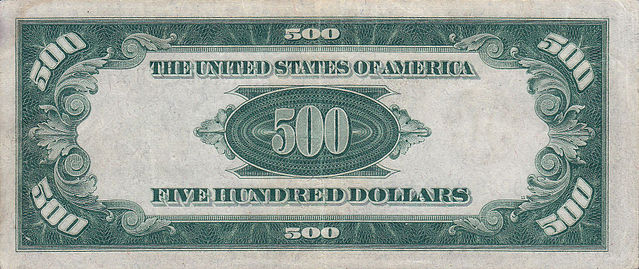 |
This is a file from the Wikimedia Commons. Information from its description page there is shown below.
Commons is a freely licensed media file repository. You can help.
|
500 dollars bill (not in use today)
Series: 1928 & 1934
Portrait: William McKinley
| Public domainPublic domainfalsefalse |
|
This image depicts a unit of currency issued by the United States of America. If this is an image of paper currency or a coin not listed here, it is solely a work of the United States government, is ineligible for copyright, and is therefore in the public domain.
Fraudulent use of this image is punishable under applicable counterfeiting laws.
As listed by the United States Secret Service at money illustrations, the Counterfeit Detection Act of 1992, Public Law 102-550, in Section 411 of Title 31 of the Code of Federal Regulations ( 31 CFR 411), permits colour illustrations of U.S. currency provided:
- The illustration is of a size less than three-fourths or more than one and one-half, in linear dimension, of each part of the item illustrated;
- The illustration is one-sided; and
- All negatives, plates, positives, digitized storage medium, graphic files, magnetic medium, optical storage devices, and any other thing used in the making of the illustration that contain an image of the illustration or any part thereof are destroyed and/or deleted or erased after their final use.
Certain coins contain copyrights licensed to the U.S. Mint and owned by third parties or assigned to and owned by the U.S. Mint . For the United States Mint circulating coin design use policy, see ; for the policy on the 50 State Quarters, see . Also: COM:ART#Photograph of an old coin found on the Internet
|
http://www.moneyfactory.gov/document.cfm/5/42/160
File usage
The following pages on Schools Wikipedia link to this image (list may be incomplete):
Schools Wikipedia has made the best of Wikipedia available to students. SOS Childrens Villages believes education is an important part of a child's life. That's why we ensure they receive nursery care as well as high-quality primary and secondary education. When they leave school, we support the children in our care as they progress to vocational training or higher education. There are many ways to help with SOS Childrens Villages.



